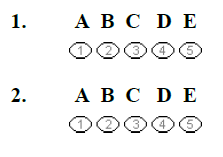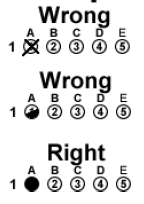
Task Lists and Tips
Task Lists
The Kentucky Medicaid Nurse Aide Test consists of seventy-five (75) written multiple-choice test items, which are taken from the following task list.
- Practice good personal hygiene
- Maintain good personal health
- Exhibit acceptable behavior
- Work cooperatively with others
- Maintain confidentiality
- Observe the Resident's Rights
- Identify and report abuse or neglect to appropriate person
- Use plan of care to meet resident's needs
- Communicate with resident, family, and staff
- Assist resident in use of intercom/call system/telephone
- Report observations/information to appropriate personnel
- Recognize health problems related to the aging process
- Recognize needs of the resident with cognitive impairment
- Assist with providing recreational activities for the resident
- Assist with giving postmortem care
- Follow standard precautions & bloodborne pathogens standard
- Hand hygiene
- Provide for environmental safety
- Adjust bed and side rails
- Assist with application of protective devices
- Report unsafe conditions to appropriate person
- Assist with care of resident with oxygen
- Follow fire and disaster plan
- Assist resident who has fallen
- Assist resident who has fainted
- Assist resident who is having a seizure
- Clear the obstructed airway - the conscious adult
- Using elevation, direct pressure, and pressure points to control bleeding
- Serve meals and collect trays
- Recognize diet modifications/restrictions
- Check food tray against diet list
- Feed or assist resident in eating
- Administer after meal care
- Record and report intake and output
- Give bed bath
- Assisting with the partial bath
- Assist resident with tub bath
- Assist resident with shower
- Make unoccupied (closed) bed
- Make occupied bed
- Perform or assist in performing oral hygiene for the conscious/unconscious resident
- Assist with or shave resident
- Give backrub
- Give perineal care
- Shampoo/groom hair
- Give nail care
- Assist resident with dressing and undressing
- provide urinary catheter care
- Provide care for the urinary incontinent resident - to include incontinence briefs
- Provide care for the bowel incontinent resident
- Assist resident in bladder retraining
- Assist resident in bowel retraining
- Assist resident in using bedpan/urinal
- Assist with enema administration
- Collect routine/clean catch urine specimen
- Collect stool specimen
- Collect sputum specimen
- Use good body mechanics
- Perform or assist with range of motion exercises
- Turn and position the resident in bed
- Transfer the resident to and from bed/chair
- Use a mechanical lift to transfer resident
- Apply and use gait belt
- Assist resident with standing/walking
- Assist resident in using cane/walker
- Transport resident by wheelchair
- Move resident between stretcher and bed
- Assist with admission, in-house transfer, and discharge of resident
- Measure and record resident temperature by using oral, auxiliary, rectal and lympanic routes using non-mercury glass/electronic thermometer
- Measure and record radial pulse
- Measure and record respiration
- Measure and record blood pressure
- Measure and record resident height/weight
- Assist in prevention of pressure/circulatory ulcers
- Apply elastic stockings
- Donning and Doffing Personal Protective Equipment
Curriculum Cross-Walks
Detailed curriculum cross-walks for all three approved textbooks are located on our website.
Tips and Examples
There are a number of skills that may help you improve your ability to take a test. Here are some tips that are strongly recommended:
- Get a good night’s rest before the test.
- Be familiar with the test directions. If anything in the directions is not clear, ask the test administrator to clarify. You will have a few minutes to ask questions before the test begins.
- Think through each question. Read each question word for word. Consider all of the answer choices. Do not choose the first answer that seems reasonable. Read and evaluate all choices to find the best answer to the question. Give careful consideration before going on to the next question, but do not spend too much time on any one question.
- When selecting the best answer to a question, do not re ad too much into the questions. The questions are written to be clear and straightforward. They are not intended to be tricky or misleading.
- If, after considering all answer choices, the correct answer is not clear, eliminate the choices you know are incorrect and choose from the remaining answers. You may want to review the questions after you have completed the rest of the test.
- Always guess even if you cannot eliminate any of the possible responses. Every question will be scored right or wrong. Your test score is based on the number of questions answered correctly. You do not lose points for incorrect answers, so you will not be penalized for guessing.
- After you have finished the test, review your answers. If possible, check all responses. Do not be afraid to change your answer. However, before changing your answer, consider the reason for your original answer.
Facilities and test candidates are encouraged to schedule the test so they do not work 12 hours prior to the competency evaluation.
Example questions:
1. A specimen colleged by having the resident cough up a substance from the lungs and bronchial tubes is called
- saliva
- mucus
- sputum
- spit
2. You see bruises on a resident's face. You should notify
- a state agency responsible for abuse
- the charge nurse
- the family
- the physician
Recording Responses
Each question will have an associated series of bubbles marked with with the letter that corresponds to the answer choice for the question.
You should be sure to fully fill in the bubble corresponding to your answer. Bubbles with only partial fill, Xs or checks in the bubble will not be counted.
The skills demonstration aspect of the examination must consist of a minimum performance of five randomly selected skills
The following skills will be used for test purposes. At least 70% of the steps must be performed correctly in each skill. Some of the steps within a skill are considered critical and must be performed at 100% accuracy. An asterisk (*) identifies the critical steps.
A critical step is defined as a step within a task that relates to physical safety of the resident or nurse aide or medical asepsis (infection control).
Sequencing of steps will not be considered critical unless it becomes a physical safety or medical asepsis violation as defined above.
The skills test is not designed to teach. The skills test is designed to measure competency. No help will be given.
All test candidates are expected to complete the skills in a timely manner. At the evaluator’s discretion, you may be given a 5-minute warning to finish the current skill.
Evaluator interactions are very limited. You may ask your evaluators questions, but the evaluator may or may not be able to answer you.
Candidates frequently stop demonstrating skills to review the steps in their mind but the evaluators cannot read your mind or your intent at this time. You may want to verbalize those steps out loud to ensure the evaluator understands your actions. Make sure you are demonstrating each step. The same applies if you are quiet because you are finished. Please let the evaluator verbally know that you are finished with each skill.
For clarification of procedures, test candidates are encouraged to refer to the procedure checklist in your workbook.
Promoting Safety and Comfort: Bed Rails - page 156 of the approved text Safety
You raise the bed to give care. Follow these safety measures to prevent the person from falling:
- For a person who uses bed rails – Always raise the far bed rail if you are working alone. Raise both bed rails if you need to leave the bedside for any reason.
- For the person who does not use bed rails – Ask a co-worker to help you. The co-worker stands on the far side of the bed. This protects the person from falling.
- Never leave the person alone when the bed is raised.
- Always lower the bed to its lowest position when you are finished giving care.
Comfort
The person has to reach over raised bed rails to access items on the bedside stand and overbed table. Such items include the water pitcher and cup, tissues, phone, and TV and light controls. Adjust the overbed table so it is within the person’s reach. Ask if the person wants other items nearby. Place them on the overbed table too. Always make sure needed items, including the signal light, are within the person’s reach.
For the purpose of testing, the resident’s care plan indicates side rails are not to be used. Side rails will be raised when the bed is raised. Side rails will be lowered when the bed is lowered.
42 C.F.R 483.13(a) provides that “the resident has the right to be free from any physical or chemical restraints imposed for discipline or convenience, and not required to treat the resident’s medical symptom.” Centers for Medicare & Medicaid Services (CMS) defines “physical restraints” in the State Operations Manual (SOM), Appendix PP as, “any manual method or physical or mechanical device, material, or equipment attached or adjacent to the resident’s body that the individual cannot remove easily which restricts movement or normal access to one’s body.”
You will be expected to perform the skills as you would in a nursing home setting. When water is required, water may be used. All candidates will be required to perform the Hand Hygiene skill. The evaluator will inform you after you have performed hand hygiene for the first time that you should tell him or her when you would perform hand hygiene during your performance of the rest of the skills rather than actually washing them for each skill. No other steps will give you credit for simply verbalizing to the evaluator what you would do, or for simulating the step, unless noted in this study guide next to that particular step within a skill. To receive credit for all other steps, you must actually demonstrate the step.
The test will consist of five of the 28 skills.


